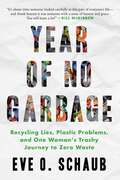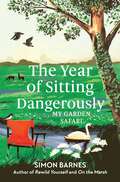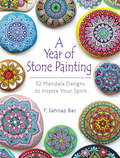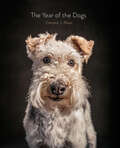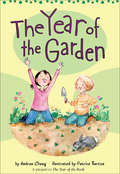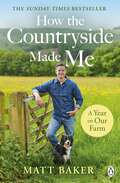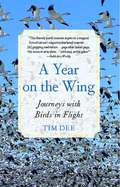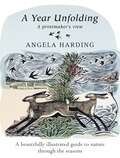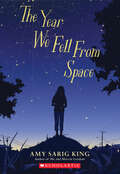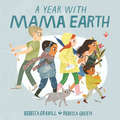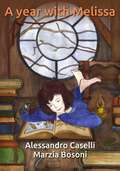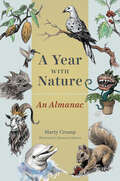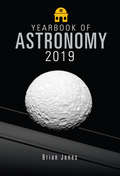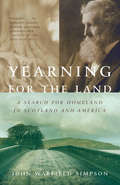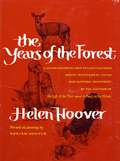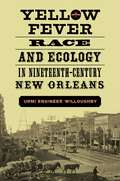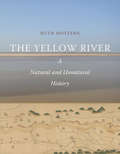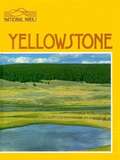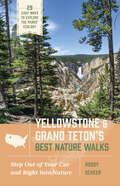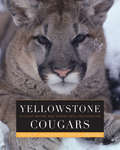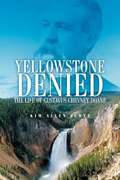- Table View
- List View
Year of No Garbage: Recycling Lies, Plastic Problems, and One Woman's Trashy Journey to Zero Waste
by Eve O. Schaub"Eve&’s brave and honest experiment reveals the shocking impact of the throwaway society we&’ve become and at the same time showing small ways we can all do better.&” —Rebecca Prince-Ruiz, founder of Plastic Free JulyYear of No Garbage is Super Size Me meets the environmental movement. In this book Eve O. Schaub, humorist and stunt memoirist extraordinaire, tackles her most difficult challenge to date: garbage. Convincing her husband and two daughters to go along with her, Schaub attempts the seemingly impossible: living in the modern world without creating any trash at all. For an entire year. And- as it turns out- during a pandemic. In the process, Schaub learns some startling things: that modern recycling is broken, and single stream recycling is a lie. That flushable wipes aren&’t flushable and compostables aren&’t compostable. That plastic drives climate change, fosters racism, and is poisoning the environment and our bodies at alarming rates, as microplastics are being found everywhere, from the top of Mount Everest to the placenta of unborn babies. If you&’ve ever thought twice about that plastic straw in your drink, you&’re gonna want to read this book.
The Year of Sitting Dangerously: My Garden Safari
by Simon BarnesFrom the acclaimed author of Rewild Yourself comes a brilliant new book that reveals the natural joys to be discovered on your doorstep. In the autumn of 2020, Simon Barnes should have been leading a safari in Zambia, but Covid restrictions meant his plans had to be put on hold. Instead, he embarked on the only voyage of discovery that was still open to him. He walked to a folding chair at the bottom of his garden, and sat down. His itinerary: to sit in that very same spot every day for a year and to see - and hear - what happened all around him. It would be a stationary garden safari; his year of sitting dangerously had begun. For the next twelve months, he would watch as the world around him changed day by day. Gradually, he began to see his surroundings in a new way; by restricting himself, he opened up new horizons, growing even closer to a world he thought he already knew so well.The Year of Sitting Dangerously is a wonderfully evocative read; it inspires the reader to pay closer attention to the marvels that surround us all, and is packed with handy tips to help bring nature even closer to us.
A Year of Stone Painting: 52 Mandala Designs to Inspire Your Spirit
by F Sehnaz BacYou can craft a new mandala every week for one year with this full-color guide by the author of the bestselling The Art of Stone Painting. F. Sehnaz Bac, an artist and seasoned archaeologist, presents step-by-step instructions for fifty-two projects. Her easy-to-follow guide will show you how to transform ordinary stones into inspirational works of art. The mandala — derived from the Sanskrit word for "circle" — represents the universe, and the symbol has long been instrumental to sacred rituals and meditative practices. This treasury of radiant designs presents patterns for stone paintings, each of which is accompanied by a one-word mantra — relax, tranquil, spirit, dream, believe, and other uplifting terms. A few projects are meant to be painted on sea glass, leaves, or shells, but most are based on Bac's popular interpretations of classic stone-based styles. Colorful photographs accompany simple instructions for a year of crafting inspiration.
The Year of the Dogs
by Vincent J. MusiFrom an opera-loving Labrador to a tooting bulldog, a chronicle of the character and personality of everyday dogs from a National Geographic photographer. Discover the stunning collection of photographs that shows the majesty, playfulness, and joy that is man&’s best friend: As a National Geographic photographer, taking pictures of lions, tigers, and bears was a regular day&’s work for Vincent Musi, but in 2017 he gave himself a new challenge: dogs. Using the same lighting and photographic techniques he uses for his National Geographic photography, Musi spent a year shooting portraits of dogs and compiling them into a book complete with all of the tail wags, wet noses, and dogs of all shapes and sizes. With delightful and informative bios displayed next to each portrait, The Year of the Dogs will have you entertained and doggedly coming back for more. &“This gorgeous tribute to man&’s best friend is the perfect gift for the dog-lover in your life—or anyone who needs to be convinced that dogs have just as much personality as humans.&” —The Pioneer Woman &“You&’ve probably seen work by Vincent Musi before. He&’s a regular National Geographic photographer and his work has covered topics like volcanoes, illegal immigration, global warming, hurricanes and the like. His latest book, though, is quite different in subject matter. It&’s a book about dogs—your average pet pooch—and it&’s fabulous . . . Paging through the book is a delight.&” —Photo District News &“For the dog lover who also loves photography, you can&’t go wrong with this coffee table book from photographer Vincent J. Musi.&” —InStyle (Holiday Gift Pick)
The Year of the Garden (Anna Wang #5)
by Andrea Cheng Patrice BartonWhen Anna is gifted a copy of The Secret Garden, it inspires her to follow her dreams—maybe she can plant ivy and purple crocuses and the birds will come. Or maybe what grows from her dream of a garden is even better: friendship. And friendship, like a garden, often has a mind of its own. In this prequel to The Year of the Book, join Anna in a year of discovery, new beginnings, friendships, and growth.
A Year on Our Farm: How the Countryside Made Me
by Matt BakerEscape into nature with Matt Baker's fascinating journey through the natural year and family life on the farm'A delight' Countryfile Magazine_______Matt Baker finds his calm on the farm.Surrounded by nature with his family, dogs, array of sheep, Mediterranean miniature donkeys and a whole host of wildlife in the farm's ancient woodland, Matt shows us how the power and beauty of the countryside can bring joy to us all.Following the ever-changing seasons of the year, we see woodland animals emerge after a long winter of hibernation and lambs begin to gambol in April. We hear the dawn chorus in the height of summer and see the preparations unfold for the harsh and wild winter months.Peppered with hand drawn sketches, unforgettable moments from Matt's TV career and stories of a landscape you'll fall in love with - from its sun-soaked pastures to 6ft snow drifts - Matt reveals how the outdoors has made him who he is today.
A Year on the Farm (Season to Season)
by Christina Mia GardeskiFrom mending fences to seedlings and combines, life on the farm changes from season to season. Discover what farmers do in winter. Learn how crops are harvested in fall. Real-life photographs follow the seasons and capture the beauty of a year on the farm.
Year on the Wing
by Tim DeeBirds--those "upgiven ghosts" who shape our skies--and their many styles of flying have inspired us for centuries. Enthralled with birds since he was a young boy, Tim Dee describes their allure in compelling, poetic prose as he follows these magnificent creatures on land, at sea, and in the air over the course of a year. A memoir of the author's life as well as a stirring account of bird migrations and the enticements of flight, the book explores the ideas and feelings that birds awaken by their flying. A Year on the Wing is also a significant chronicle of Dee's rich reading of a gorgeous literary and naturalist tradition about birds, and achieves a marvelous commingling of nature and language, finding meaning and a fascinating beauty in the quiver of a redstart's tail, in the thrilling skydiving stoop of the once-endangered now resurgent peregrine falcon, and the nocturnal restlessness of migrant woodcocks. Watching birds instills a renewed sense of wonder in us all, and this beautifully written memoir celebrates birds and the inspiration they give as it expands our horizons.e inspiration they provide through their twice-yearly winged migrations.
A Year Unfolding: A Printmaker's View
by Angela HardingA beautifully illustrated guide to nature through the seasons by much-loved printmaker Angela Harding.The cover of this stunning book has an exclusive triptych printed on the reverse - a perfect collector's itemThis stunning work, the first book that is solely dedicated to Angela's art, is a celebration of her beautiful prints, and a glimpse into her detailed and meticulous process.A Year Unfolding is a journey through Angela's year in nature watching the seasons unfold in front of her from her studio in Rutland, and giving the reader detail into how nature transforms and evolves over the course of the year.A Year Unfolding also tells the stories behind some of Angela's most popular images, giving context to Angela's celebrated work, as well as new art created specifically for the book.The beautiful illustrations and evocative imagery of the prose make this the perfect book for Angela's fans and readers and art lovers everywhere.
A Year Unfolding: A Printmaker's View
by Angela HardingA beautifully illustrated guide to nature through the seasons by much-loved printmaker Angela Harding.The cover of this stunning book has an exclusive triptych printed on the reverse - a perfect collector's itemThis stunning work, the first book that is solely dedicated to Angela's art, is a celebration of her beautiful prints, and a glimpse into her detailed and meticulous process.A Year Unfolding is a journey through Angela's year in nature watching the seasons unfold in front of her from her studio in Rutland, and giving the reader detail into how nature transforms and evolves over the course of the year.A Year Unfolding also tells the stories behind some of Angela's most popular images, giving context to Angela's celebrated work, as well as new art created specifically for the book.The beautiful illustrations and evocative imagery of the prose make this the perfect book for Angela's fans and readers and art lovers everywhere.Angela has created the covers for many bestselling books, including The Salt Path and The Wild Silence by Raynor Winn, October, October by Katya Balen, English Pastoral by James Rebanks, Christmas is Murder by Val McDermid and RSPB Birds among many others.
The Year We Fell From Space
by Amy Sarig KingLiberty Johansen is going to change the way we look at the night sky. Most people see the old constellations, the things they've been told to see. But Liberty sees new patterns, pictures, and possibilities. She's an exception. Some other exceptions:Her dad, who gave her the stars. Who moved out months ago and hasn't talked to her since.Her mom, who's happier since he left, even though everyone thinks she should be sad and lonely.And her sister, who won't go outside their house. Liberty feels like her whole world is falling from space. Can she map a new life for herself and her family before they spin too far out of reach?
A Year with Mama Earth
by Rebecca GrabillIn September, Mama Earth sighs out the first autumn frost, which crunches under children&’s feet. Mama Earth looks after nature&’s plants and animals throughout the year—singing lullabies to fat bears in the fall, dressing evergreens in icicles in winter, and waking up the crocuses in spring. And in the summer, Mama Earth sends warm sunbeams to her beloved children, so they can play outside and enjoy the amazing world around them.With enchanting text and radiant artwork, A Year with Mama Earth offers a joyous celebration of nature&’s beauty and the changing seasons.
A Year with Melissa
by Alessandro Caselli Marzia BosoniRespect for the environment, animals and ourselves - this is what the inquisitive Melissa, a 6-year-old girl discusses with Mr Cat, a wise stray cat. Six stories told over the course of one year in the life of the little girl to share a little of the wisdom accumulated by the cat over years travelling the world. Through these stories, the cat asks adults to stop and reflect for a moment on the important subjects such as ecology, pollution, pain and friendship. A children's book that appeals to adults who still know how to find the time to talk with their little ones. And Cats!
A Year with Nature: An Almanac
by Marty Crump Bronwyn McIvorA Year with Nature is an almanac like none you’ve ever seen: combining science and aesthetics, it is a daily affirmation of the extraordinary richness of biodiversity and our enduring beguilement by its beauty. With a text by herpetologist and natural history writer Marty Crump and a cornucopia of original illustrations by Bronwyn McIvor, this quirky quotidian reverie gazes across the globe, media, and time as it celebrates date-appropriate natural topics ranging from the founding of the National Park Service to annual strawberry, garlic, shrimp, hummingbird, and black bear festivals. With Crump, we mark the publication of classics like Carson’s Silent Spring and White’s Charlotte’s Web, and even the musical premiere of Tchaikovsky’s Swan Lake. We note the discovery of the structure of DNA and the mountain gorilla, the rise of citizen science projects, and the work of people who’ve shaped how we view and protect nature—from Aristotle to E. O. Wilson. Some days feature US celebrations, like National Poinsettia Day and National Cat Day; others highlight country-specific celebrations, like Australia’s Wombat Day and Thailand’s Monkey Buffet Festival, during which thousands of macaques feast on an ornately arranged spread of fruits and vegetables. Crump also highlights celebrations that span borders, from World Wildlife Conservation Day to International Mountain Day and global festivities for snakes, sea turtles, and chocolate. Interweaving fascinating facts on everything from jellyfish bodies to monthly birth flowers with folkloric entries featuring the Loch Ness Monster, unicorns, and ancient Greek, Roman, and Egyptian mythology, the almanac is as exhaustive as it is enchanting. A Year with Nature celebrates the wonder and beauty of our natural world as we have expressed it in visual arts, music, literature, science, natural history, and everyday experience. But more than this, the almanac’s vignettes encourage us to contemplate how we can help ensure that future generations will be able to enjoy the landscapes and rich biodiversity we so deeply cherish.
Yearbook of Astronomy, 2019
by Brian JonesAn inspiration to amateur and professional astronomers alike, the Yearbook of Astronomy warrants a place on the bookshelf of all sky watchers and stargazers. Maintaining its appealing style and presentation, the Yearbook of Astronomy 2019 contains an authoritative set of sky charts and comprehensive jargon-free monthly sky notes to enable backyard astronomers everywhere to plan their viewing of the years eclipses, comets, meteor showers and deep sky objects.In addition, a variety of entertaining and informative articles present the reader with information on a wide range of topics including, among others, The Cassini-Huygens Mission to the Saturn System; 100 Years of the International Astronomical Union; The First Micro-Quasar; Getting the Measure of Double Stars; Asaph Hall: Man of Mars; and Science Fiction and the Future of Astronomy.The Yearbook of Astronomy has been around for well over half a century and, as it heads towards its Diamond Jubilee edition in 2022, continues to be essential reading for anyone lured by the magic of astronomy and who wants to extend their knowledge of the Universe and the wonders it plays host to.
Yearning for the Land: A Search for the Importance of Place
by John W. SimpsonA beautiful, meditative memoir mixed with travel and history, this unique book is the story of one American's search for a deeper connection to the land. Drawn by a sense that he is missing a critical link to his home in suburban Ohio, John W. Simpson heads for rural Scotland, where he encounters his own family history as well as estate owners and tenant farmers who have centuries-long ties to their land. As he travels, he meditates on the legacy of the great 19th century conservationist John Muir, who himself developed a complex love of the land when he immigrated from Scotland's North Sea coast to the fields and forests of Wisconsin. As Simpson physically retraces Muir's journey he wonders what sense of belonging Muir found on the frontier that modern America, with its strip malls and housing developments, has forgotten. A fascinating story of changing perceptions and values from the Old World to the New, Yearning for the Land shows us just how much roots matter--both in our own lives, and in the many ways time and history, landscape and community are tightly intertwined.From the Trade Paperback edition.
The Years of the Forest
by Helen HooverFrom the book: What does it really mean, what does it really entail day by day, to give up urban comforts for the deeper delights of wilderness living? One day, shortly after Helen and Adrian Hoover first fled city life to make a home for themselves in a remote cabin in the Minnesota woods, Ade scribbled a casual list (the last item then seemed almost a whimsical joke) of Things to Do: clear brush, install wiring, Clear paths, put in running water, clear trash, inside toilet, remodel icehouse, clear small cabin, Build dock, Cut wood, Lay hardwood floor, get another car, fix roof, make a living, Finish inside, Take a vacation. it was a random enough list. It didn't even include such matters as Food, Telephone (of course there was none in the isolated cabin). Other books by Helen Hoover are available from Bookshare.
YEARS OF THE FOREST
by Helen HooverThis is a book that takes us inside the Hoovers' wilderness home during those sixteen Years of the Forest and lets us experience not only the joys and the techniques but also the challenges and travails of going it alone in the beautiful but not always accommodating wilderness, far from the technology and services that city people take for granted. It is a book of wilderness adventure, it is an education in the ingenuities of wilderness housekeeping, filled with practical details about making do, building and rebuilding, gardening for fun and for food, even advice about getting away from getting-away-from-it-all. Good times and Hard times, good neighbors and bad neighbors, the strains engendered by conflicting views--and passions--about the use of the environment: Mrs. Hoover shares her experience without stint. But above all--over, under, and all around her straightforward and practical approach to life in the wilderness--there is, as always, the sensitive and moving awareness of nature (especially of the animals with whom she and her husband shared the forest, often helping them through starving winters) that is the special quality of her writing and her life.
Yellow Eyes
by Rutherford MontgomeryYellow Eyes raised and faced about. His amber eyes shone and his ears were laid back. In an instant he struck again and sent the leader of the pack hurtling from the cliff. Against dogs, man, and natural enemies the fierce American cougar fights to keep his rule supreme in the high mountain country of the West.
Yellow Fever, Race, and Ecology in Nineteenth-Century New Orleans (The Natural World of the Gulf South #8)
by Urmi Engineer WilloughbyThrough the innovative perspective of environment and culture, Urmi Engineer Willoughby examines yellow fever in New Orleans from 1796 to 1905. Linking local epidemics to the city’s place in the Atlantic world, Yellow Fever, Race, and Ecology in Nineteenth-Century New Orleans analyzes how incidences of and responses to the disease grew out of an environment shaped by sugar production, slavery, and urban development.Willoughby argues that transnational processes—including patterns of migration, industrialization, and imperialism—contributed to ecological changes that enabled yellow fever–carrying Aedes aëgypti mosquitoes to thrive and transmit the disease in New Orleans, challenging presumptions that yellow fever was primarily transported to the Americas on slave ships. She then traces the origin and spread of medical and popular beliefs about yellow fever immunity, from the early nineteenth-century contention that natives of New Orleans were protected, to the gradual emphasis on race as a determinant of immunity, reflecting social tensions over the abolition of slavery around the world.As the nineteenth century unfolded, ideas of biological differences between the races calcified, even as public health infrastructure expanded, and race continued to play a central role in the diagnosis and prevention of the disease. State and federal governments began to create boards and organizations responsible for preventing new outbreaks and providing care during epidemics, though medical authorities ignored evidence of black victims of yellow fever. Willoughby argues that American imperialist ambitions also contributed to yellow fever eradication and the growth of the field of tropical medicine: U.S. commercial interests in the tropical zones that grew crops like sugar cane, bananas, and coffee engendered cooperation between medical professionals and American military forces in Latin America, which in turn enabled public health campaigns to research and eliminate yellow fever in New Orleans.A signal contribution to the field of disease ecology, Yellow Fever, Race, and Ecology in Nineteenth-Century New Orleans delineates events that shaped the Crescent City’s epidemiological history, shedding light on the spread and eradication of yellow fever in the Atlantic World.
The Yellow River: A Natural and Unnatural History (Yale Agrarian Studies Series)
by Ruth MosternA three-thousand-year history of the Yellow River and the legacy of interactions between humans and the natural landscape From Neolithic times to the present day, the Yellow River and its watershed have both shaped and been shaped by human society. Using the Yellow River to illustrate the long-term effects of environmentally significant human activity, Ruth Mostern unravels the long history of the human relationship with water and soil and the consequences, at times disastrous, of ecological transformations that resulted from human decisions. As Mostern follows the Yellow River through three millennia of history, she underlines how governments consistently ignored the dynamic interrelationships of the river&’s varied ecosystems—grasslands, riparian forests, wetlands, and deserts—and the ecological and cultural impacts of their policies. With an interdisciplinary approach informed by archival research and GIS (geographical information system) records, this groundbreaking volume provides unique insight into patterns, transformations, and devastating ruptures throughout ecological history and offers profound conclusions about the way we continue to affect the natural systems upon which we depend.
Yellowstone
by Carol MarronDescribes the geography, including the geysers, hot springs, mud pots, and fumaroles, and plants and animals of Wyoming's Yellowstone Park. Includes a history of the park.
Yellowstone and Grand Teton’s Best Nature Walks: 29 Easy Ways to Explore the Parks' Ecology
by Roddy ScheerPlan out your trip on some of America's most beautiful natural wonders with this indispensable guide to the flora, fauna, geology, and hiking trails of Yellowstone and the Grand Tetons. Step out of your car and right into nature! Yellowstone and Grand Teton&’s Best Nature Walks by Roddy Scheer guides you through simple hikes that feature the best of the park&’s rich ecology. Each entry starts with the brief description of the hike's level of difficulty—all are gentle to moderate and cover no more than two miles. Entries also include directions and clear descriptions of the flora, fauna, and geology you are likely to encounter along the way. Yellowstone and Grand Teton&’s Best Nature Walks is a must-have guide for outdoor enthusiasts, hikers, and tourists.
Yellowstone Cougars: Ecology before and during Wolf Restoration
by Toni K. Ruth Polly C. Buotte Maurice G. HornockerYellowstone Cougars examines the effect of wolf restoration on the cougar population in Yellowstone National Park—one of the largest national parks in the American West. No other study has ever specifically addressed the theoretical and practical aspects of competition between large carnivores in North America. The authors provide a thorough analysis of cougar ecology, how they interact with and are influenced by wolves—their main competitor—and how this knowledge informs management and conservation of both species across the West. Of practical importance, Yellowstone Cougars addresses the management and conservation of multiple carnivores in increasingly human-dominated landscapes. The authors move beyond a single-species approach to cougar management and conservation to one that considers multiple species, which was impossible to untangle before wolf reestablishment in the Yellowstone area provided biologists with this research opportunity. Yellowstone Cougars provides objective scientific data at the forefront of understanding cougars and large carnivore community structure and management issues in the Greater Yellowstone Ecosystem, as well as in other areas where wolves and cougars are reestablishing. Intended for an audience of scientists, wildlife managers, conservationists, and academics, the book also sets a theoretical precedent for writing about competition between carnivorous mammals.
Yellowstone Denied: The Life of Gustavus Cheyney Doane
by Kim Allen ScottFrontier soldier and explorer extraordinaire, Gustavus Cheyney Doane was no stranger to historical events. Between 1863 and 1892, he fought in the Civil War, participated in every major Indian battle in Montana Territory, and led the first scientific reconnaissance into the Yellowstone country. He was always close to being at the right place at the right time to secure lasting fame, yet that fame eluded him, even after his death. Finally, Kim Allen Scott rescues Doane from obscurity to tell the tale of an educated and inventive man who strove in vain for recognition throughout his life. Yellowstone Denied is a psychological portrait of a complex and intriguing individual. Raised in the West after traveling the Oregon Trail with his family, Doane enlisted in the “California Hundred” to fight for the Union. After a failed foray into politics, he returned to the army and headed the military escort of the first government exploration of Yellowstone in 1870. His report on that expedition attracted congressional recognition and contributed to the establishment of Yellowstone National Park but did not make Doane a household name. He fought the Sioux in 1876, the Nez Perces in 1877, and Geronimo in 1886. He also took part in preparations for the ill-fated Greeley Arctic expedition of 1881. During his thirty years in uniform, Doane nearly achieved the celebrity he sought, but twists of fate and, at times, his own questionable behavior denied it in the end. Scott’s critical biography now examines the man’s accomplishments and failures alike, and traces the frustrated efforts of Doane’s widow to see her husband properly enshrined in history. Yellowstone Denied is also a revealing look at military culture, scientific discovery, and western expansion, and it gives Doane the credit long denied him.
